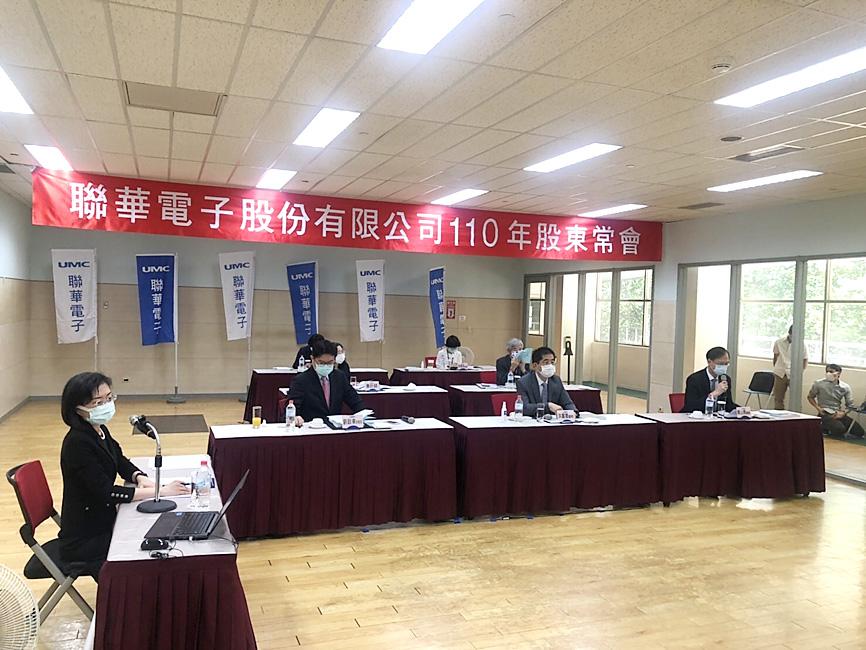The global semiconductor shortage is expected to last until 2023 as the COVID-19 pandemic boosts demand for chips for automobiles and smart home devices, United Microelectronics Corp (UMC, 聯電) copresident Chien Shan-chieh (簡山傑) said yesterday.
Speaking at the company’s annual general meeting in Hsinchu, Chien said that while the COVID-19 pandemic has had an adverse impact on the global economy, digital transformation has accelerated growth in the semiconductor industry.
Chip supply would fall short of demand and only worsen in the short term, with a shortage of 8-inch and 12-inch wafers set to be the most severe, Chien said.

Photo: Grace Hung, Taipei Times
As demand continues to soar, the global chip shortage is likely to last beyond next year until 2023, he said.
To solve the problem, the key is to increase capacity, Chien said, but added that even with chipmakers investing in fabs to expand capacity, it would take until 2023 for more chips to be produced.
UMC’s revenue grew 26 percent in US dollar terms last year, while its operating income surged to NT$22.01 billion (US$786.27 million), reflecting solid utilization rates across both 8-inch and 12-inch facilities, and optimization of the company’s blended product mix, he said.
Of particular note has been the company’s enhanced 12-inch product mix, which is primarily a result of the substantial pickup in the 28-nanometer wafer business, as well as the successful integration of 12-inch operations at its Japanese subsidiary United Semiconductor Japan Co, he added.
Shareholders of UMC, the world’s third-largest contract chipmaker, yesterday during the online meeting approved a plan to distribute a NT$1.6 cash dividend.
The company last year posted consolidated revenue of NT$176.82 billion, or earnings per share of NT$2.42, up 19.3 percent year-on-year.

Taiwan Semiconductor Manufacturing Co (TSMC, 台積電) last week recorded an increase in the number of shareholders to the highest in almost eight months, despite its share price falling 3.38 percent from the previous week, Taiwan Stock Exchange data released on Saturday showed. As of Friday, TSMC had 1.88 million shareholders, the most since the week of April 25 and an increase of 31,870 from the previous week, the data showed. The number of shareholders jumped despite a drop of NT$50 (US$1.59), or 3.38 percent, in TSMC’s share price from a week earlier to NT$1,430, as investors took profits from their earlier gains

In a high-security Shenzhen laboratory, Chinese scientists have built what Washington has spent years trying to prevent: a prototype of a machine capable of producing the cutting-edge semiconductor chips that power artificial intelligence (AI), smartphones and weapons central to Western military dominance, Reuters has learned. Completed early this year and undergoing testing, the prototype fills nearly an entire factory floor. It was built by a team of former engineers from Dutch semiconductor giant ASML who reverse-engineered the company’s extreme ultraviolet lithography (EUV) machines, according to two people with knowledge of the project. EUV machines sit at the heart of a technological Cold

Taiwan’s long-term economic competitiveness will hinge not only on national champions like Taiwan Semiconductor Manufacturing Co. (TSMC, 台積電) but also on the widespread adoption of artificial intelligence (AI) and other emerging technologies, a US-based scholar has said. At a lecture in Taipei on Tuesday, Jeffrey Ding, assistant professor of political science at the George Washington University and author of "Technology and the Rise of Great Powers," argued that historical experience shows that general-purpose technologies (GPTs) — such as electricity, computers and now AI — shape long-term economic advantages through their diffusion across the broader economy. "What really matters is not who pioneers

TAIWAN VALUE CHAIN: Foxtron is to fully own Luxgen following the transaction and it plans to launch a new electric model, the Foxtron Bria, in Taiwan next year Yulon Motor Co (裕隆汽車) yesterday said that its board of directors approved the disposal of its electric vehicle (EV) unit, Luxgen Motor Co (納智捷汽車), to Foxtron Vehicle Technologies Co (鴻華先進) for NT$787.6 million (US$24.98 million). Foxtron, a half-half joint venture between Yulon affiliate Hua-Chuang Automobile Information Technical Center Co (華創車電) and Hon Hai Precision Industry Co (鴻海精密), expects to wrap up the deal in the first quarter of next year. Foxtron would fully own Luxgen following the transaction, including five car distributing companies, outlets and all employees. The deal is subject to the approval of the Fair Trade Commission, Foxtron said. “Foxtron will be